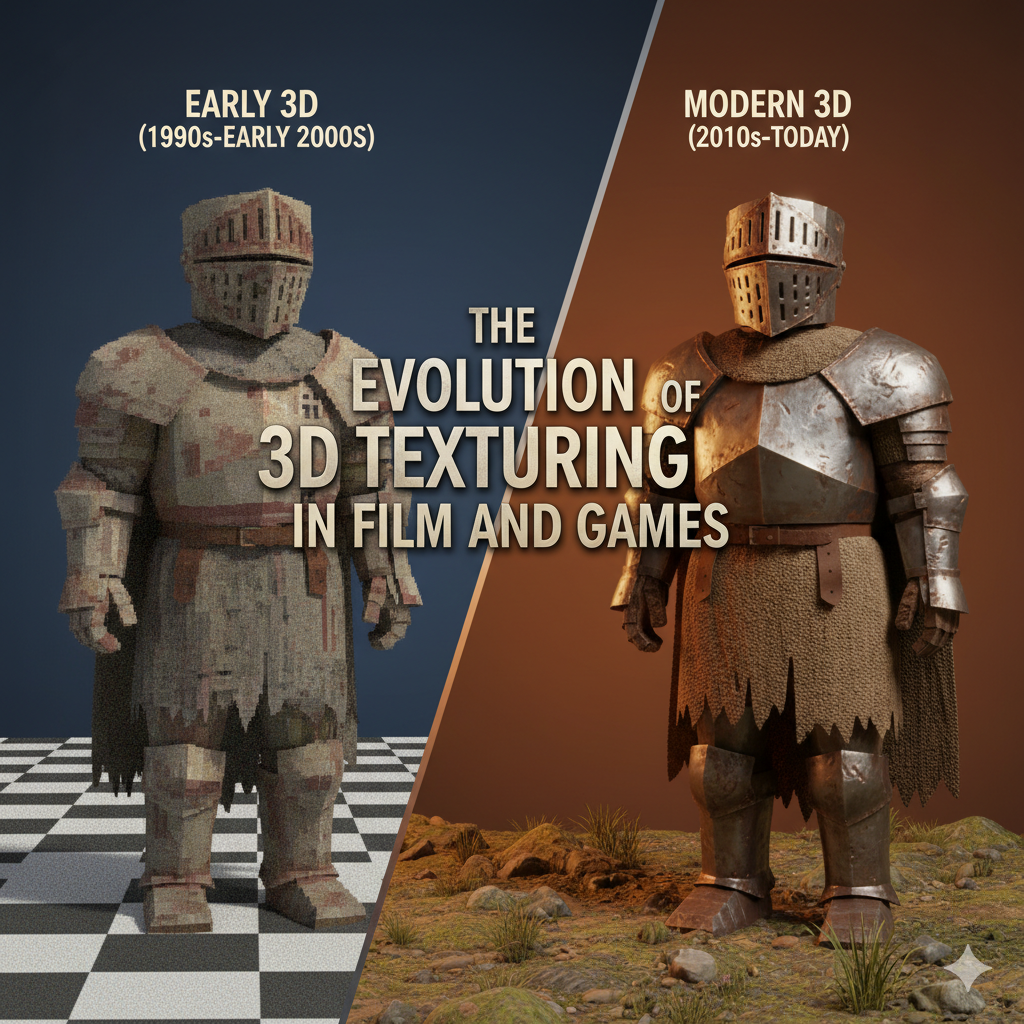Introduction
In the digital realms of blockbuster films and immersive video games, what we see often sells the fantasy. While 3D modeling creates an object’s shape, its surface quality brings it to life. This art and science, known as 3D Texturing, has undergone a radical transformation. From the flat colors of early CGI to today’s photorealistic surfaces, the evolution of 3D Texturing is a story of technological leaps and artistic innovation. This article traces that journey, exploring how new tools and techniques have shaped the worlds we love.
The Early Days: Hand-Painted Beginnings
In the infancy of 3D graphics, the process of 3D Texturing was cumbersome. Artists worked with low-resolution bitmaps, hand-painting every detail in 2D software like Photoshop. They faced a significant challenge: creating the illusion of depth and material with very limited tools.
UV mapping—the process of “unwrapping” a 3D model’s surface into a 2D layout—was a technical nightmare. Artists had to paint textures while constantly visualizing how their 2D artwork would wrap onto a complex 3D shape. Consequently, the results often appeared flat and cartoonish. This era defined a “stylized” look not always by choice, but by technical constraint. Nevertheless, pioneers in games like Super Mario 64 and films like Toy Story laid the crucial groundwork, proving that digital worlds could hold emotional weight.
A New Standard: The PBR Revolution
The most significant leap in modern 3D Texturing came with Physically Based Rendering (PBR). Before PBR, artists relied on intuition to paint highlights and shadows. In contrast, PBR introduced a scientific approach. It uses accurate material models that respond realistically to light.
The PBR workflow standardized specific map types:
- Albedo: The pure color of the material, without any lighting.
- Roughness: Defines how rough a surface is, making it appear matte or glossy.
- Metallic: Dictates how a material reflects its environment.
This shift was monumental. It democratized the creation of photorealistic surfaces and ensured assets looked consistent under different lighting. As a result, PBR became the backbone of modern 3D Texturing.
Powerful New Tools: The Software Renaissance
The rise of PBR coincided with a software revolution, led by tools like Adobe’s Substance Suite. Significantly, Substance Painter allowed artists to paint textures directly onto 3D models in a real-time viewport. This process used dynamic lighting and “smart materials” that could simulate complex surfaces like rust with a few clicks.
Furthermore, Substance Designer promoted procedural 3D Texturing. Instead of painting every detail by hand, artists built materials using node-based graphs. This non-destructive workflow allowed for incredible flexibility and rapid iteration. Therefore, the discipline evolved from a purely painterly art into a hybrid of artistry and technical design.
Modern Workflows and Scanning Technology
Today, scan-based workflows are pushing realism even further. Photogrammetry, for instance, creates 3D assets from numerous photographs of real-world objects. This technique allows artists to capture and use authentic surface data, creating a foundation of undeniable realism. Subsequently, artists often refine these scans in software like Substance Painter to perfect the final look.
The Future: AI and Real-Time Demands
Currently, two key trends are shaping the future of texturing. First, AI tools are now automating tedious tasks. For example, they can generate high-resolution detail from low-res sources or instantly create texture variations. This automation frees artists to focus on more creative decisions.
Secondly, the advent of real-time ray tracing in game engines has raised the bar again. Now, textures must hold up under physically accurate, real-time light simulation. This demand pushes the craft of 3D Texturing to new heights of subtlety and realism, especially for virtual and augmented reality.
Conclusion
The journey of 3D texturing highlights the collaboration between art and technology. It has evolved from a technical constraint to a central pillar of digital storytelling. From hand-painted origins to today’s AI-assisted workflows, the craft continues to redefine visual realism and stylistic expression. Ultimately, the surface tells its own story, and we are only just beginning to read it.
Frequently Asked Questions (FAQ)
1. What is the core difference between texturing for games and for film?
The primary difference lies in performance and lighting. In film, textures can be extremely high-resolution because studios pre-render frames over hours. In games, however, textures must be optimized for real-time rendering, using techniques like texture streaming.
2. What are the essential skills for a modern 3D texture artist?
A modern artist needs a strong foundation in traditional art principles, proficiency with software like Substance Painter, and a solid understanding of the PBR workflow. Technical knowledge of UV mapping and optimization is also crucial.
3. Is hand-painted texturing still relevant today?
Absolutely. While PBR dominates photorealistic projects, hand-painted texturing thrives in the stylized art styles of popular games like League of Legends and Genshin Impact. This style emphasizes artistic flair over physical accuracy.
4. What does “procedural texturing” mean?
Procedural texturing creates textures using mathematical algorithms and node-based systems instead of hand-painting. The key advantage is that these textures are resolution-independent, tileable, and easily adjustable.
5. How has AI begun to impact the 3D texturing workflow?
AI currently serves as a powerful assistive tool. It helps with tasks like upscaling textures, generating maps from a single photo, and creating seamless tileable textures. Therefore, it augments artists’ capabilities rather than replacing their creative direction.


1 Comment
Pingback: imagesize:2160x3840 game of thrones melisandre - Financial Technology News | Business News